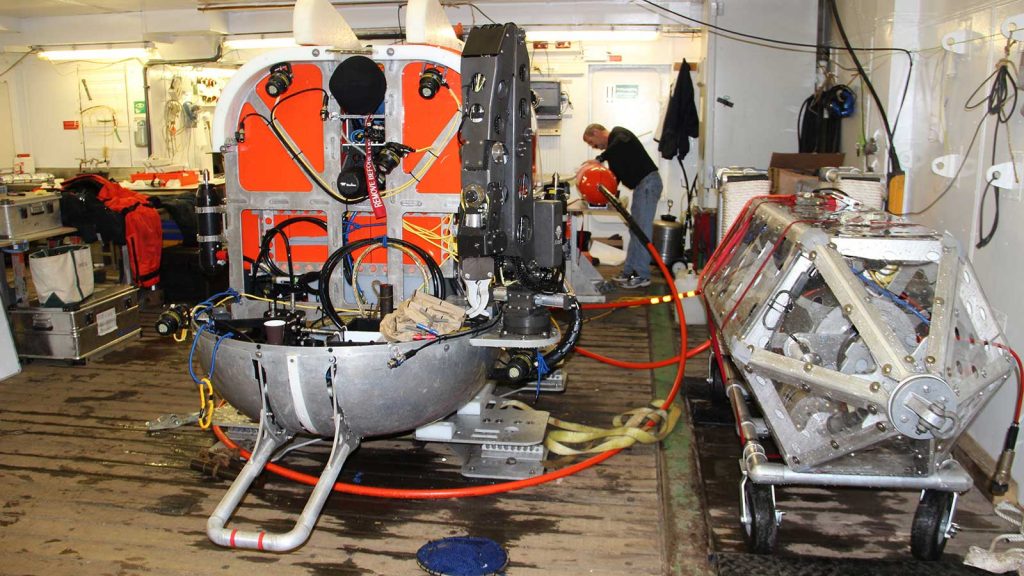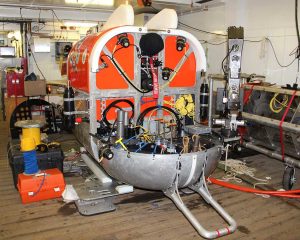
WHOI engineer John Bailey preps NUI to dive in ROV mode, with the “REMOVE BEFORE FLIGHT” tag attached to the protective cover on our primary HD video camera and the Kraft manipulator that we will be using for any sampling visible on the vehicle’s front basket. (photo by Chris German, Woods Hole Oceanographic Institution)
Tomorrow (Thursday) should be a great day—our first NUI dive to the seafloor in an ice-covered ocean with the vehicle in remotely operated mode. And I am incredibly nervous. Excited too, but simultaneously worrying about the many things that could go wrong.
First, there is the complexity of the vehicle. We had four dives with NUI operating as an ROV from the Polarstern in 2014 and they all lasted for around four hours, so there is no reason why the vehicle shouldn’t work well tomorrow. But now we are headed to the seafloor, which makes the dive infinitely more complex. And the vehicle itself is a massively complex system, as well, so while the NUI engineers are working through their pre-dive checklists to ensure all is as it should be, all I can do is stand by and be ready to hear the good news that everything is fine. Or the opposite.
So I have been inventing “busy work” to keep myself occupied, spending the morning writing up a plan outlining what I want to happen during the dive: where to go on the seafloor and why, what kinds of samples to take at each location, and who needs to be with me in the control van from the science team during different stages of the dive to make sure we get the right kinds of samples for their projects.
Indeed, that has been evolving over the past 48 hours as Casey and I talk through what sampling gear will go where in the science basket so that I will know what to ask for when. During the dive, she and I will be sitting side-by-side as pilot and science lead and I will also be on call to act as video assistant, maneuvering the main high-definition camera to show Casey whatever she needs when maneuvering the sub at the seafloor before turning my attention back to making seafloor observations. I must admit that last night, watching her and John work through the final camera tests, it finally struck me that this was real—we actually are going to dive to the bottom of an ice-covered ocean!
The final wrinkle is the weather. Today the wind has been blowing over 30 miles per hour and that means the ice is drifting faster than before. Conditions are supposed to improve overnight and if the wind drops as quickly as predicted, the ice drift will slow and we will be good to go at 8:00 a.m.

Bonus photo: NUI ready to go. (photo by Chris German, Woods Hole Oceanographic Institution)
We also have a plan B: If we are delayed for any reason, such as the weather, we can still execute the first half of the planned dive mission so long as we get in the water soon after midday. That is important because our next storm is due here on Friday.
So now I just have to sit and wait. At 2:00 p.m. I gave a briefing to the other scientists involved in tomorrow’s dive describing what to expect when. Next up is the 3:30 to decide if the vehicle is good-to-go after all pre-dive checks completed. Then, comes the daily weather forecast at 4:00.
At 5:00 a.m. tomorrow, we muster for last-minute checks of the vehicle and at 7:00 a.m. we are due to arrive on-station to see if conditions will allow us to launch.
What to do between now and each of those check points? Go chew on my little book of calm.

